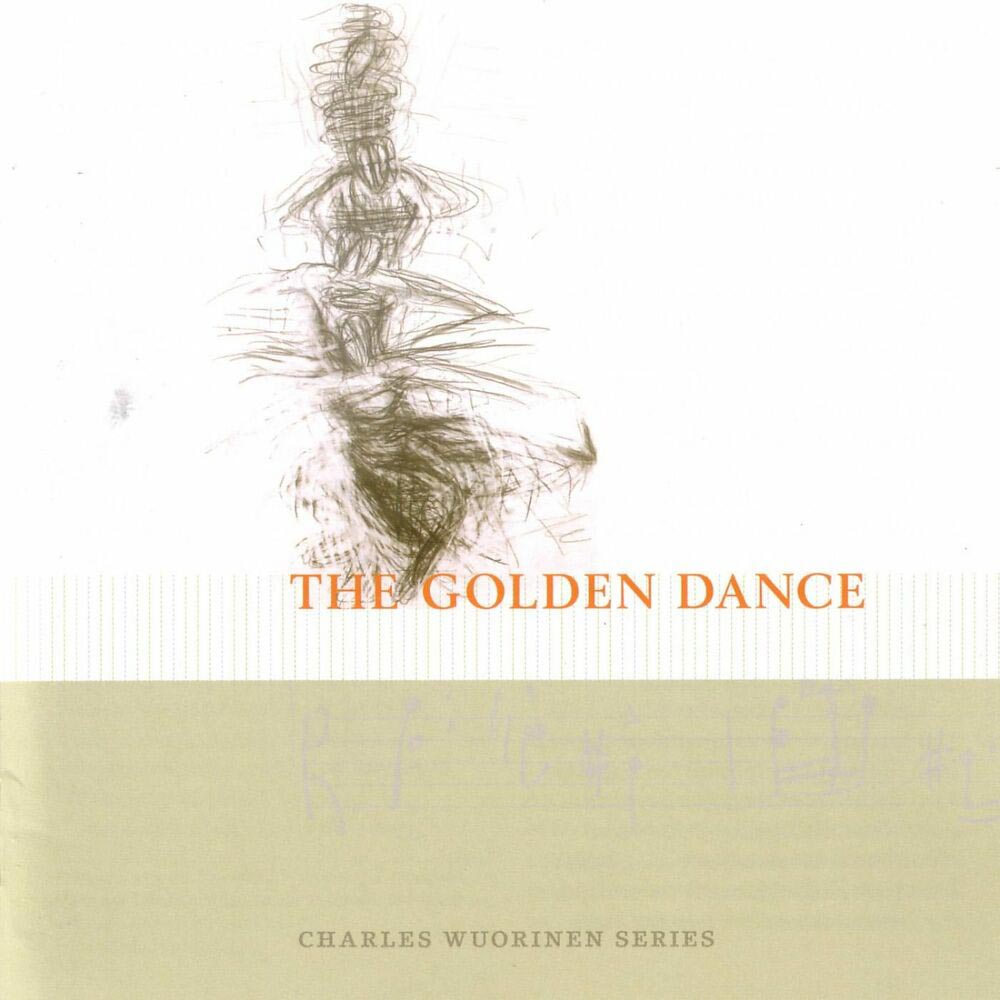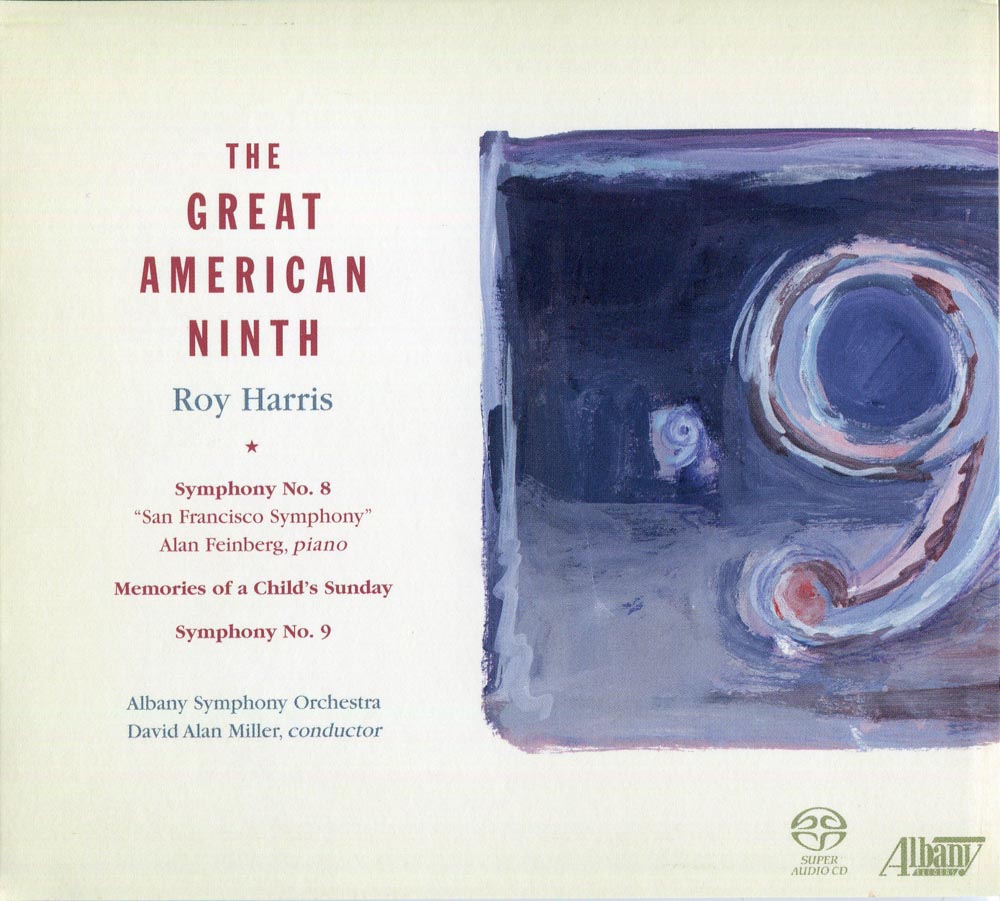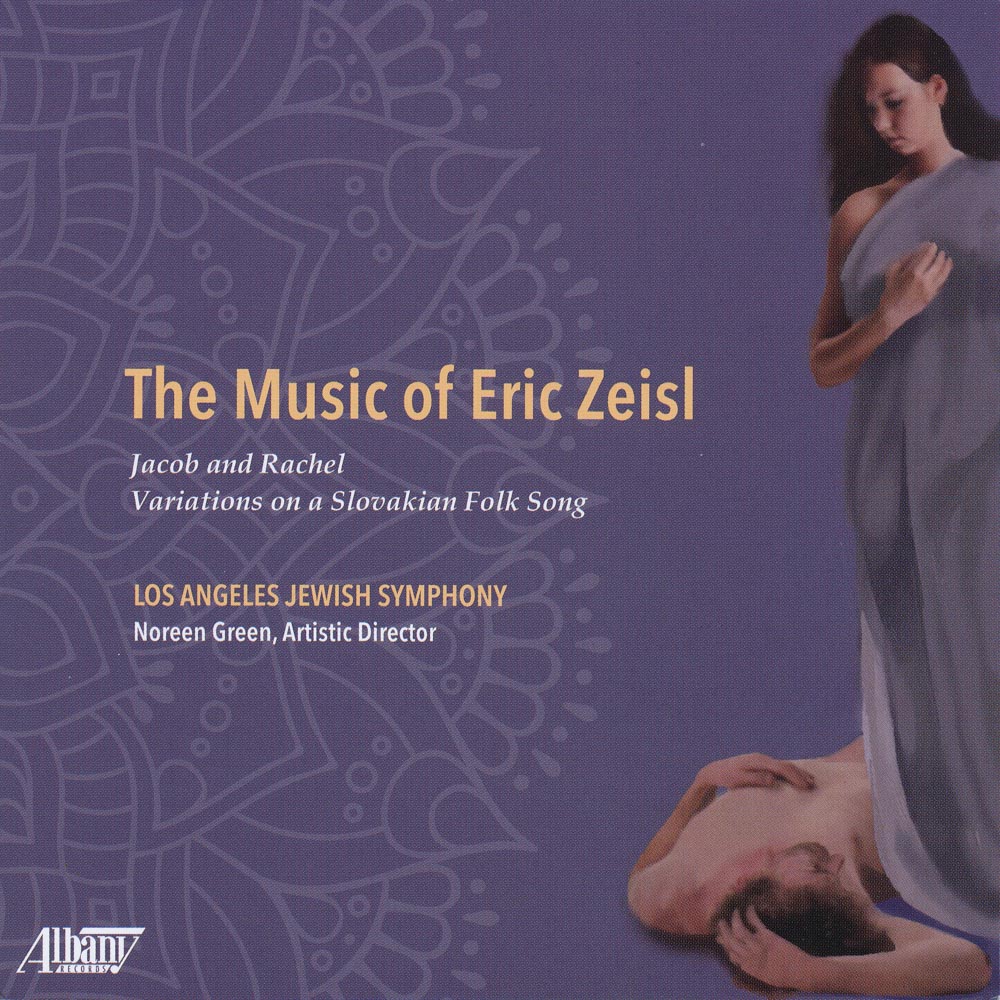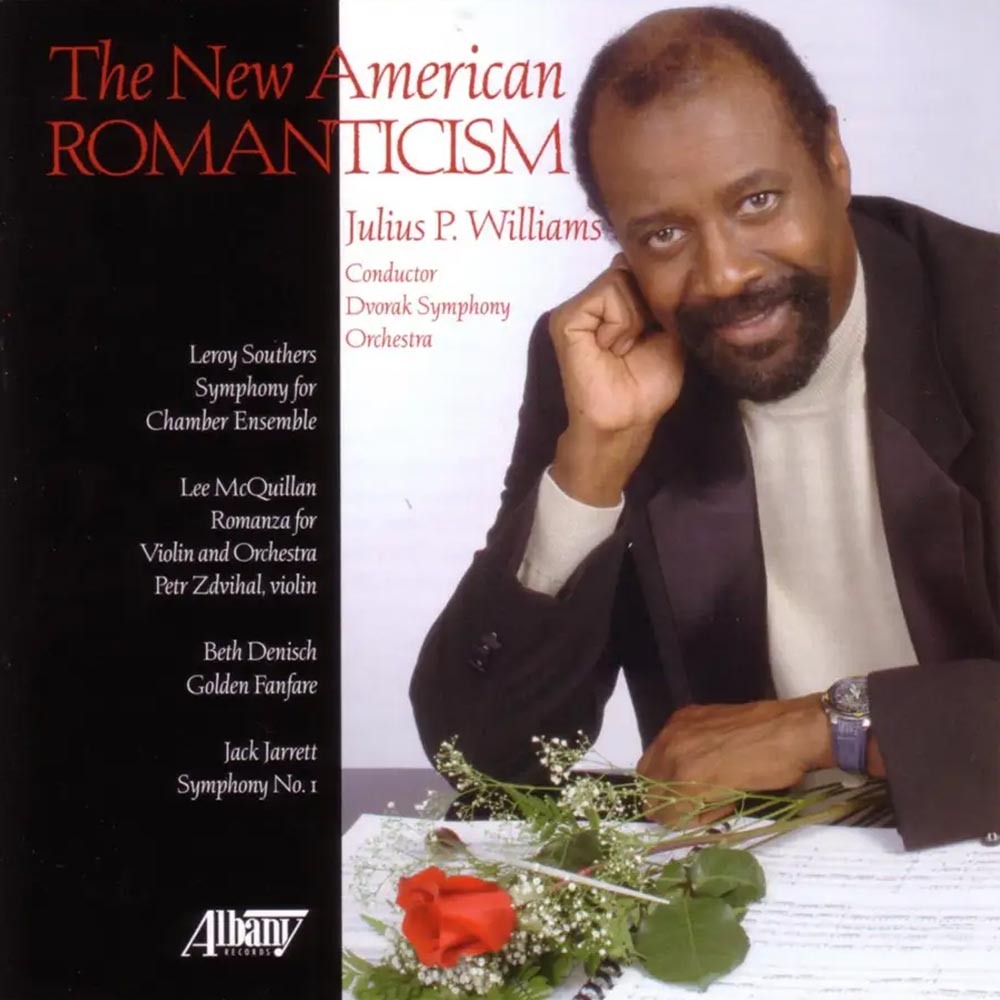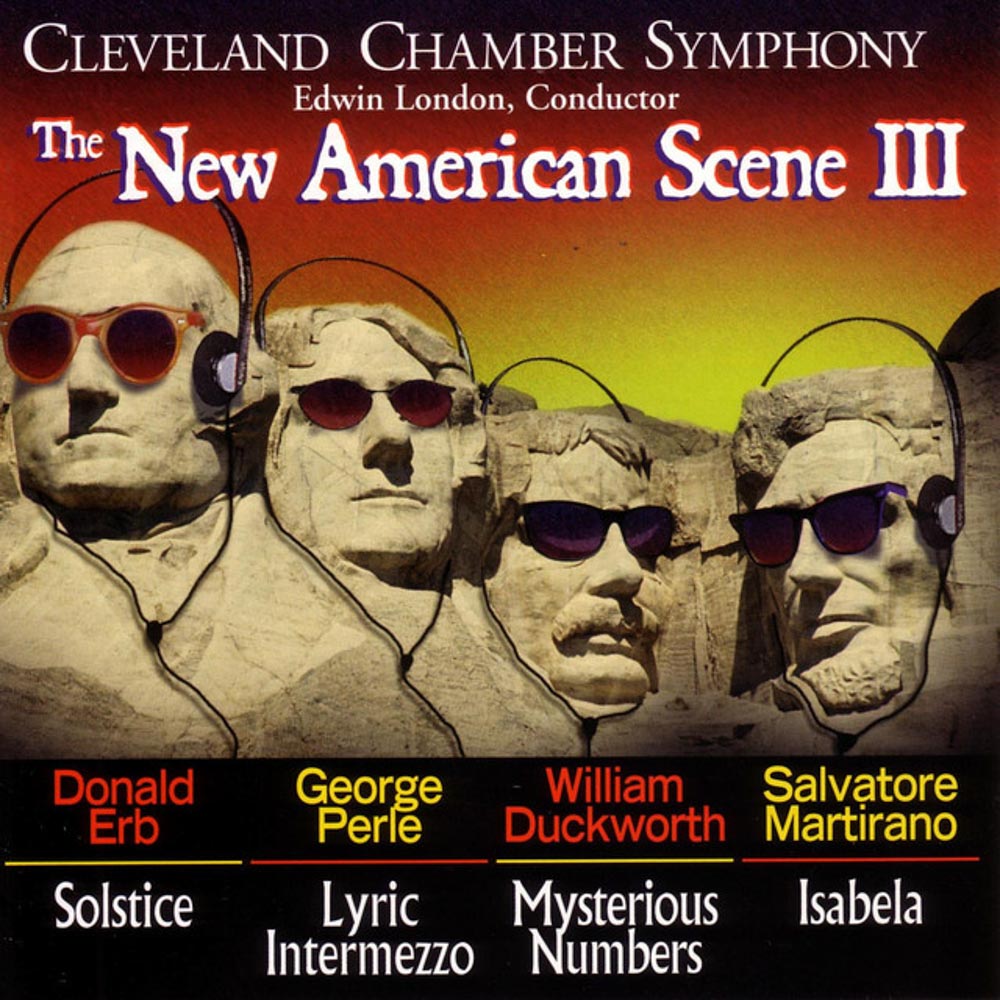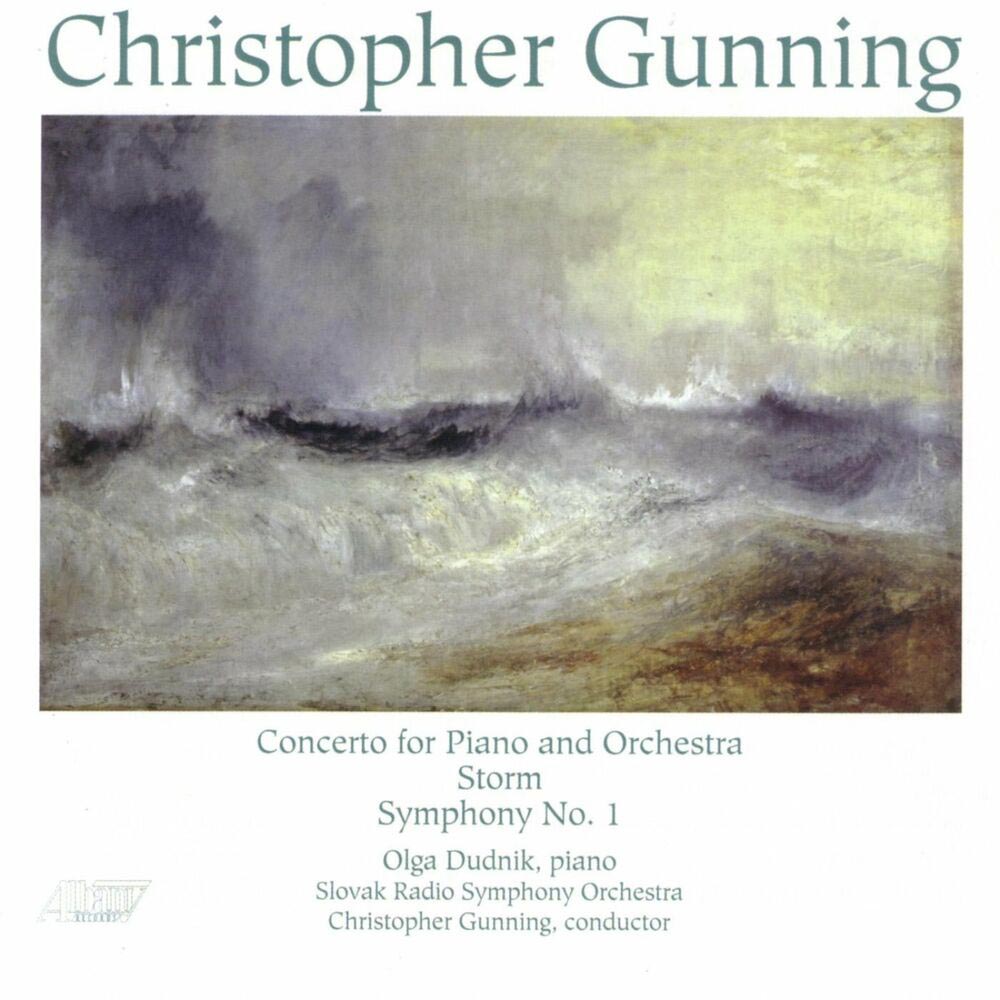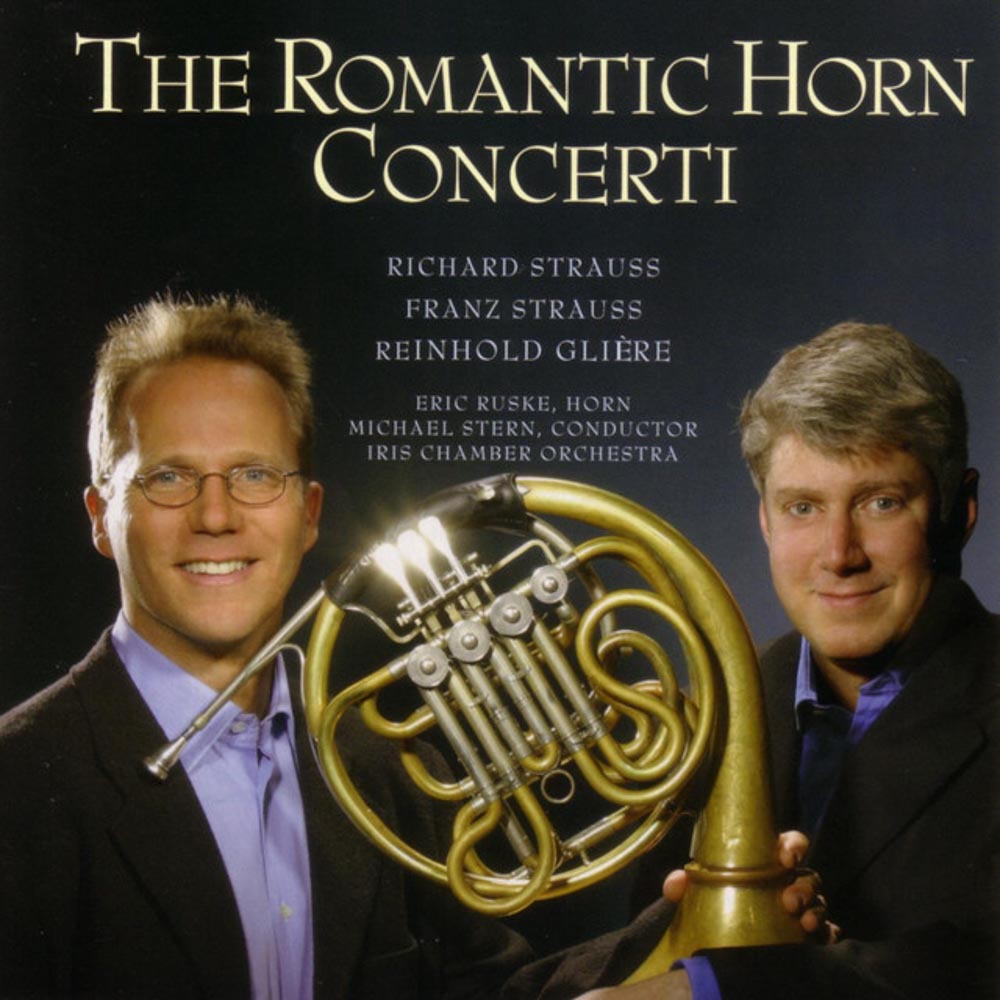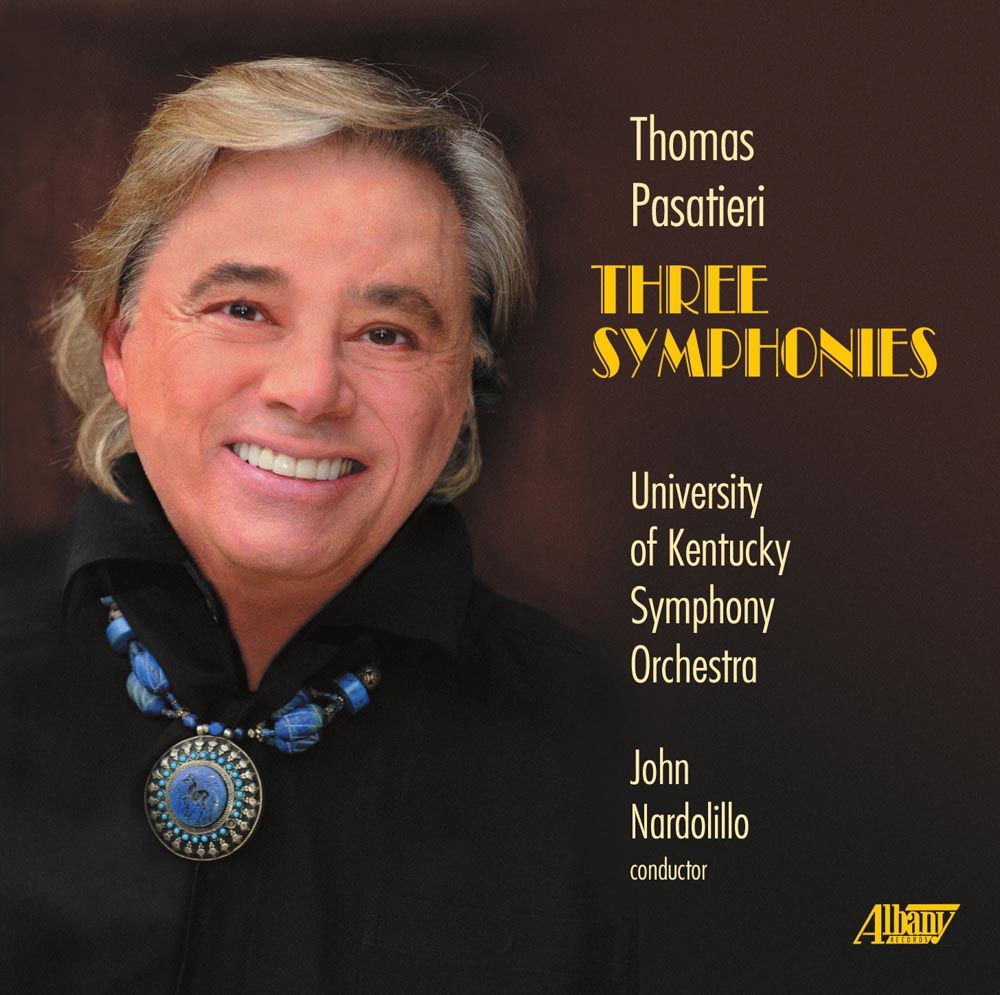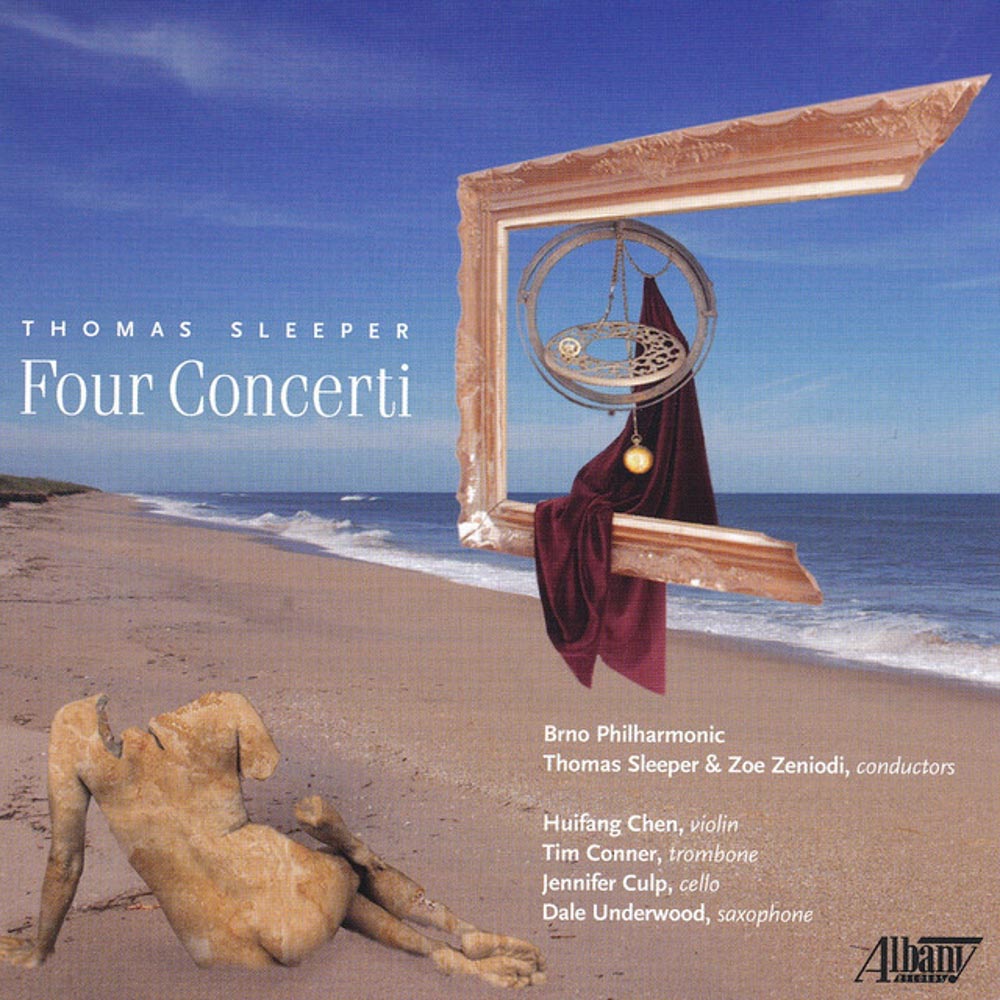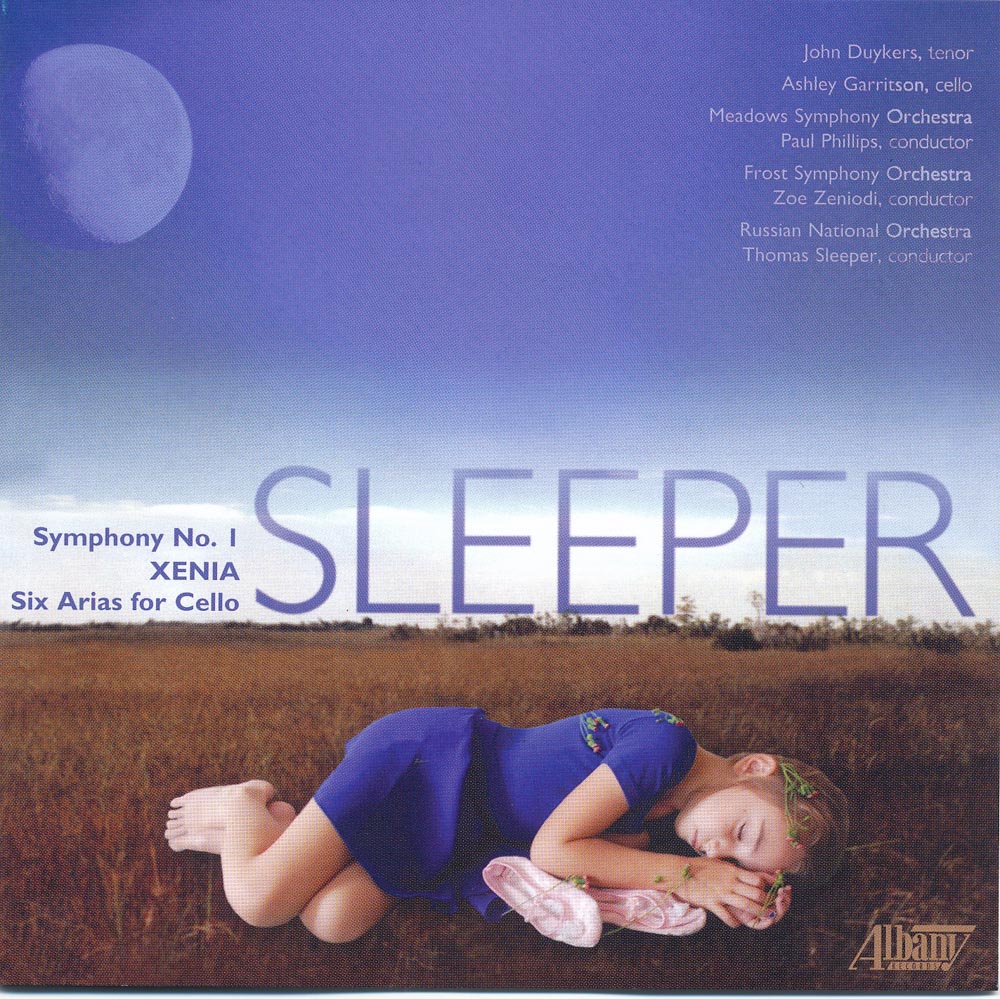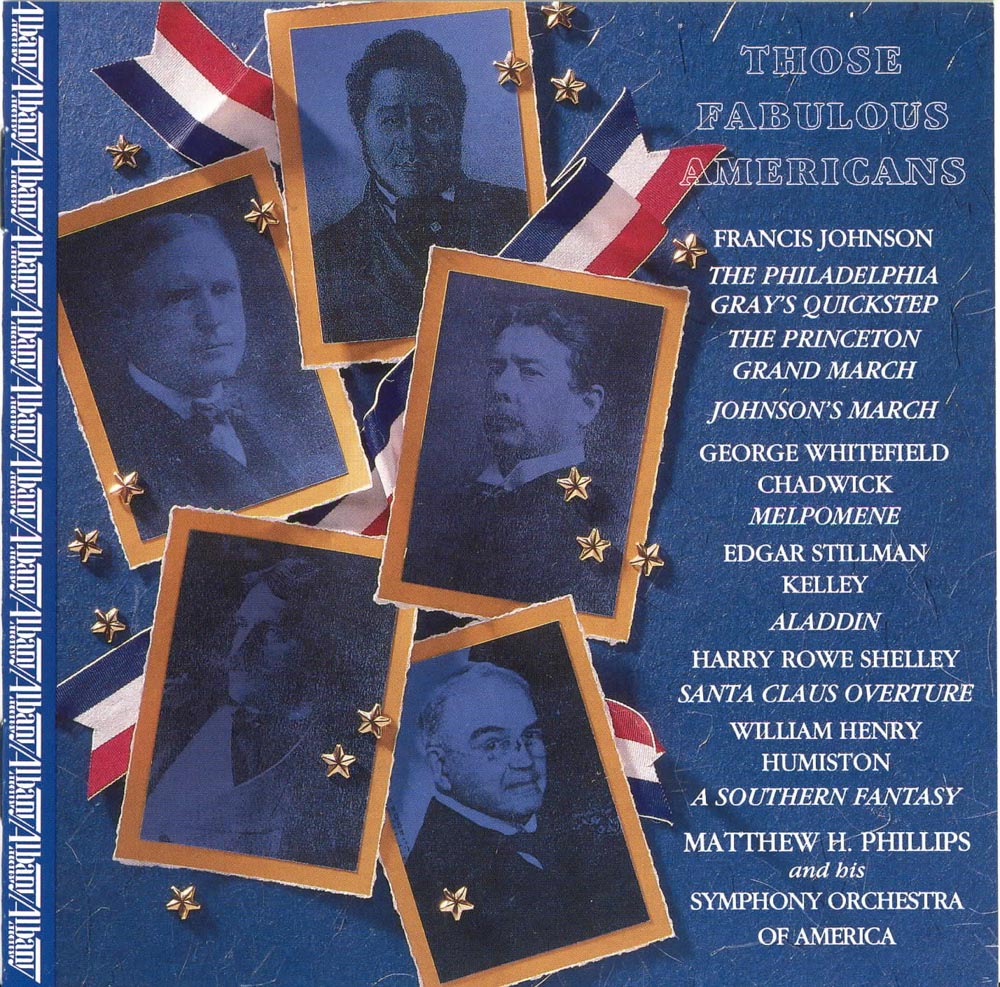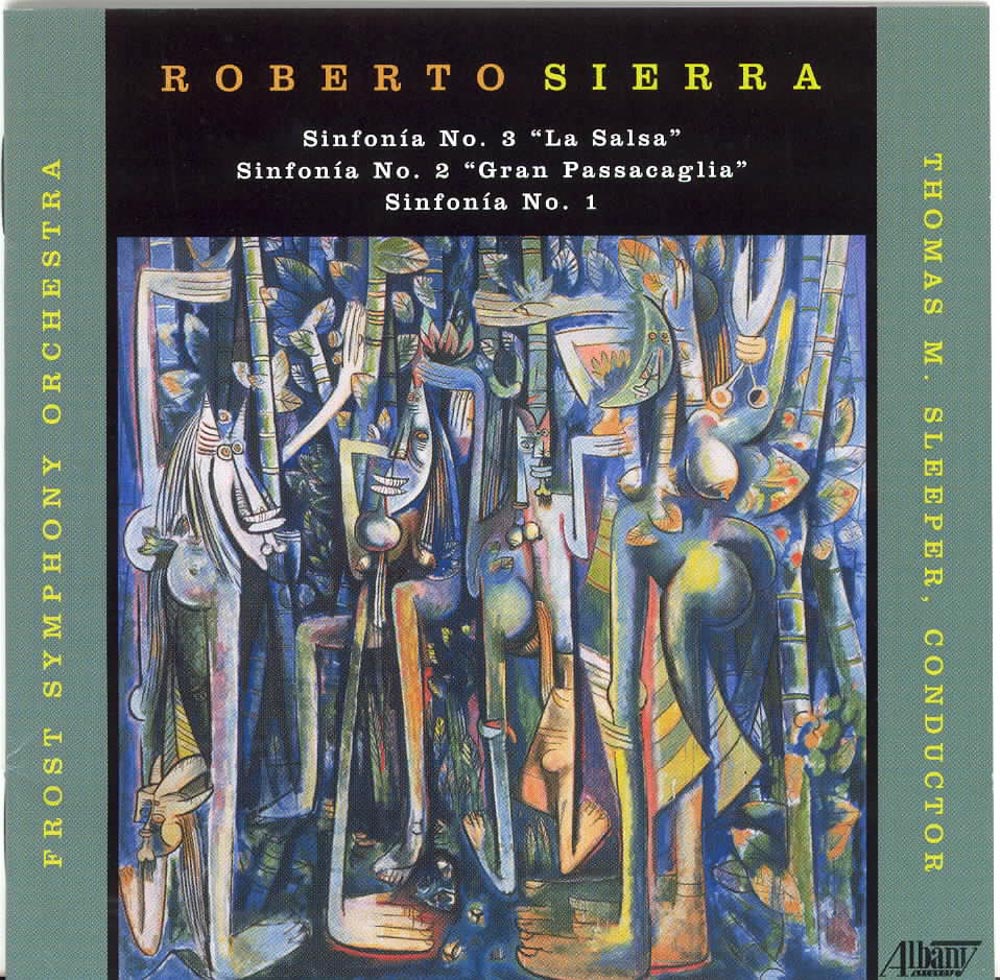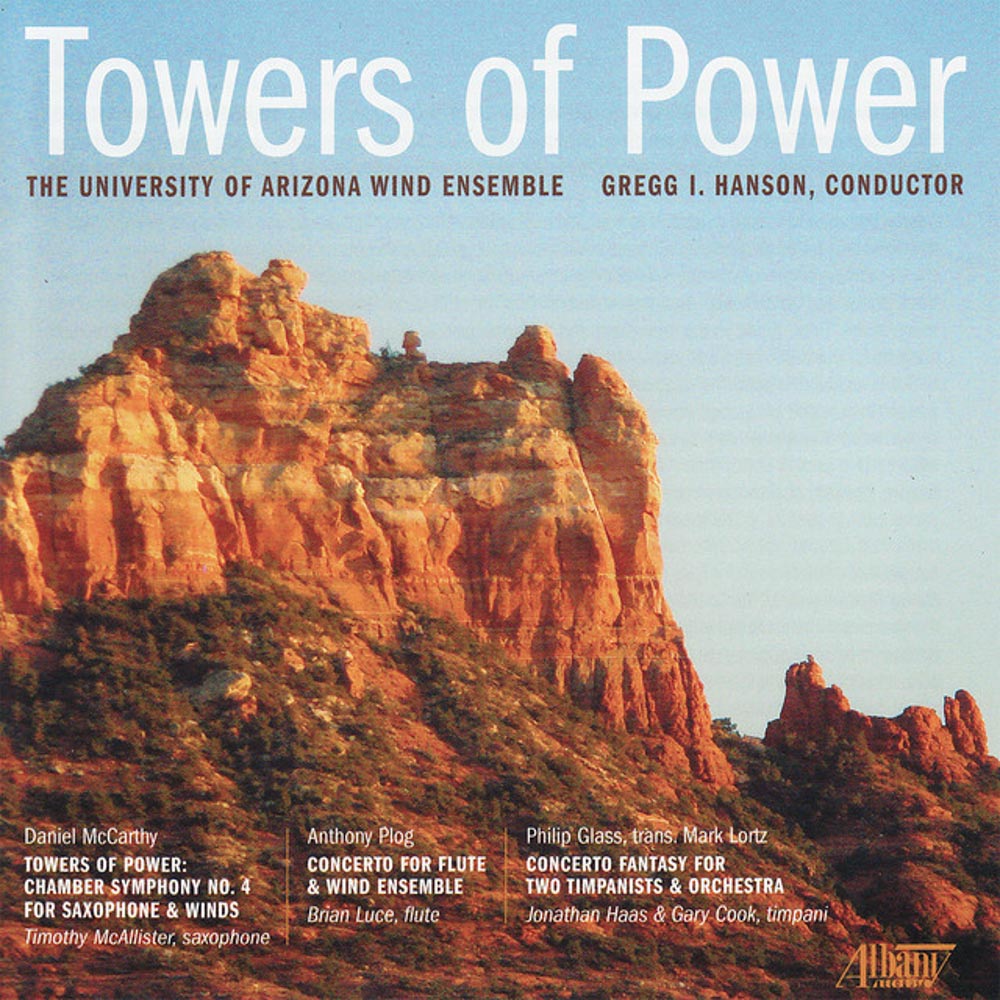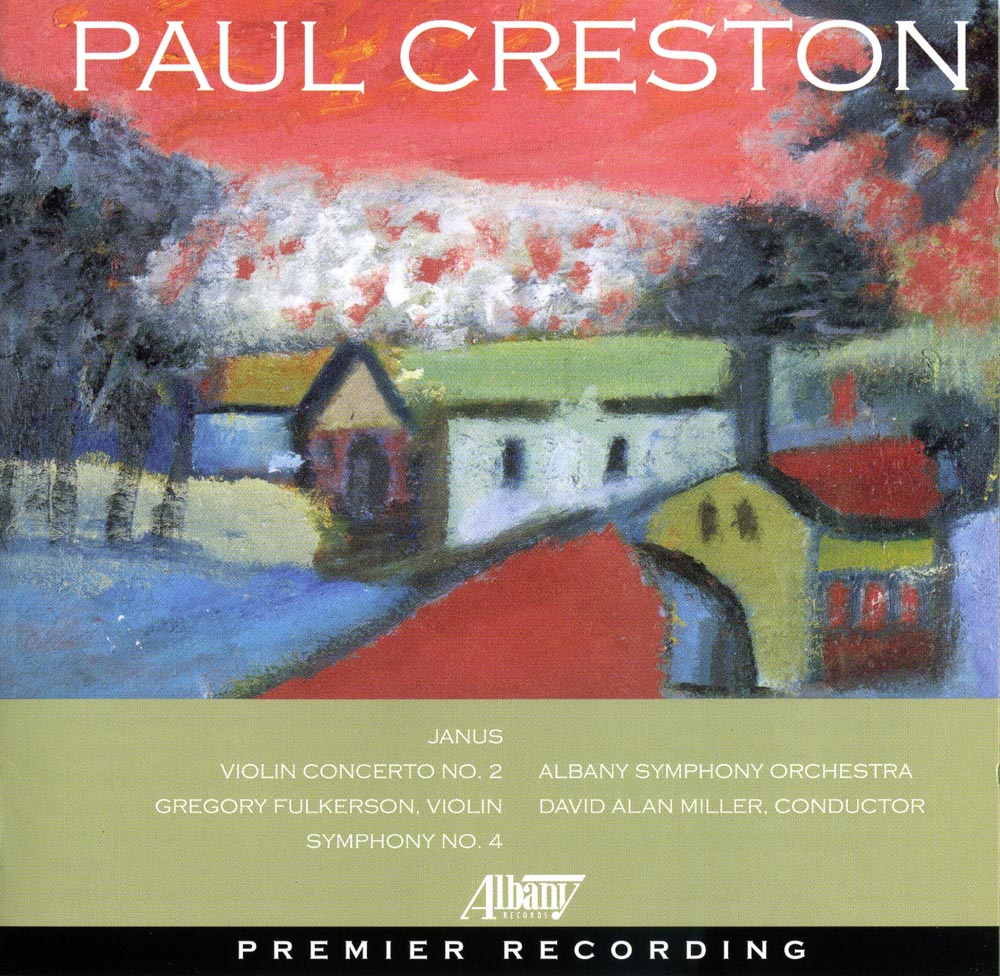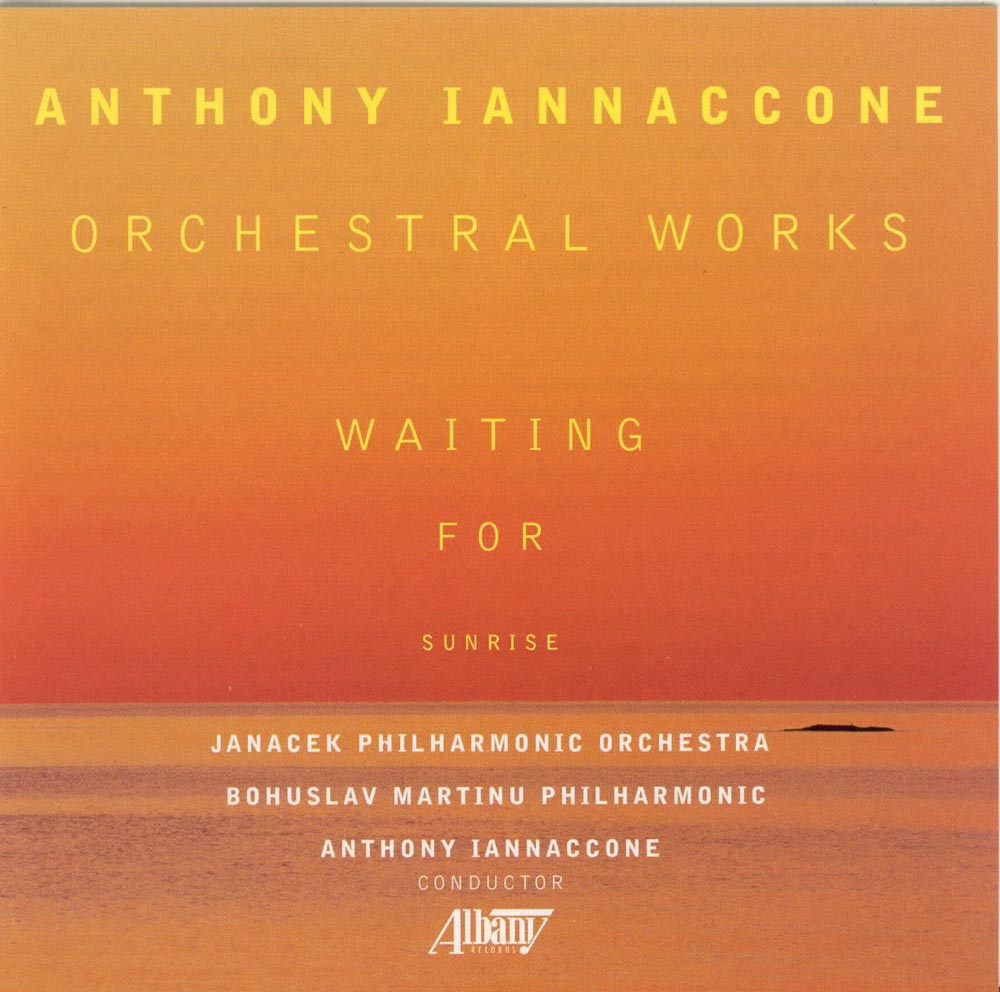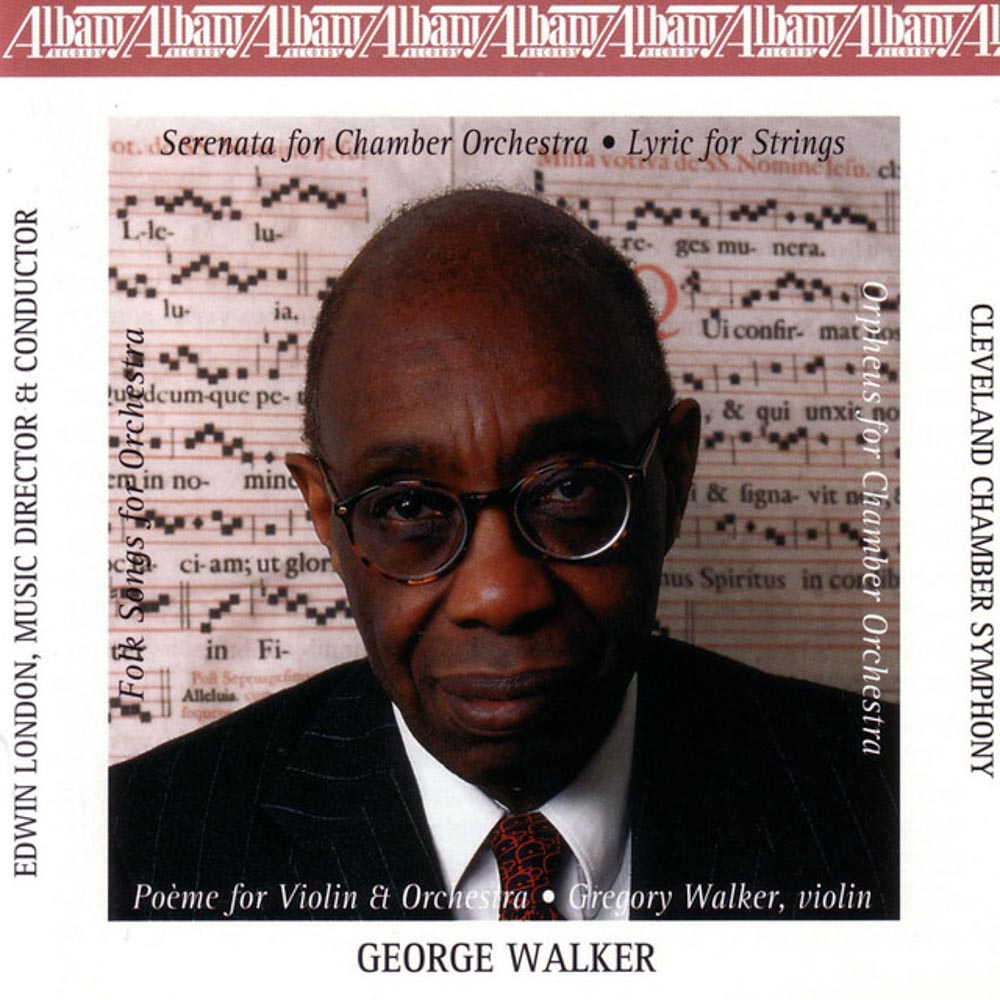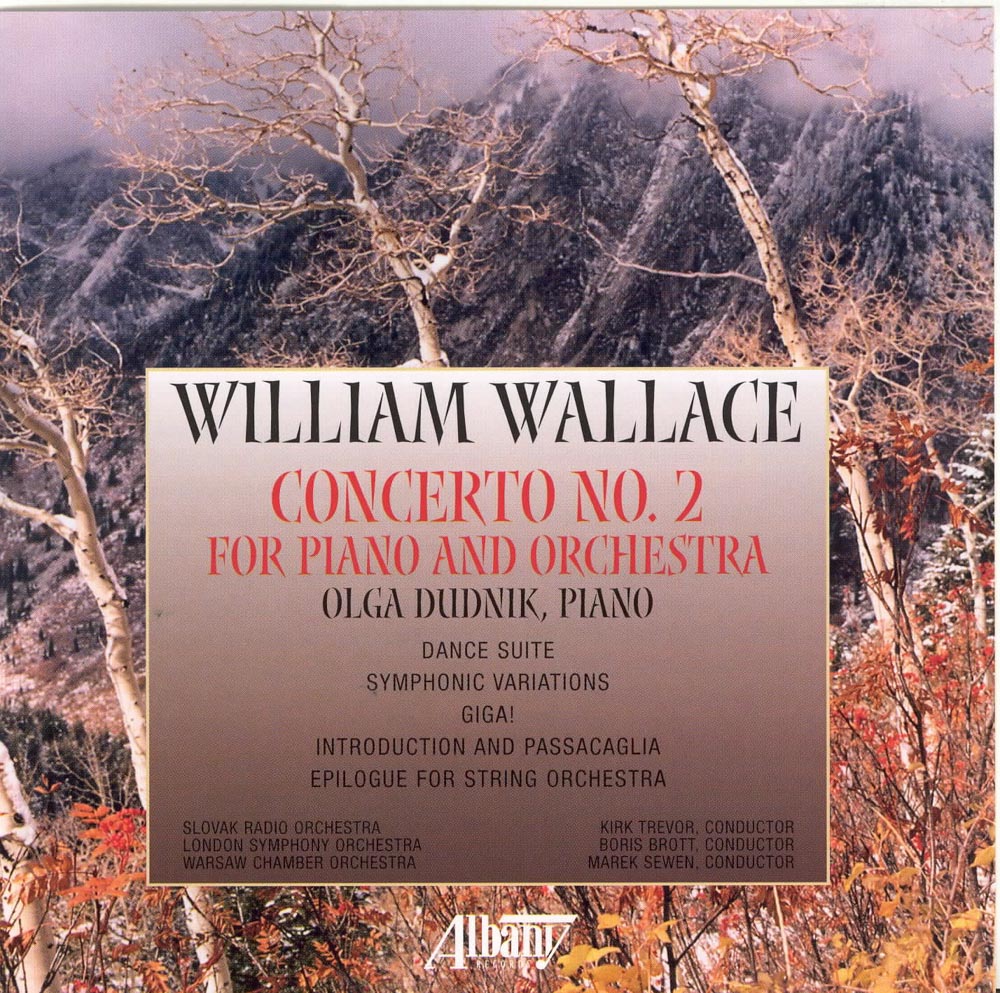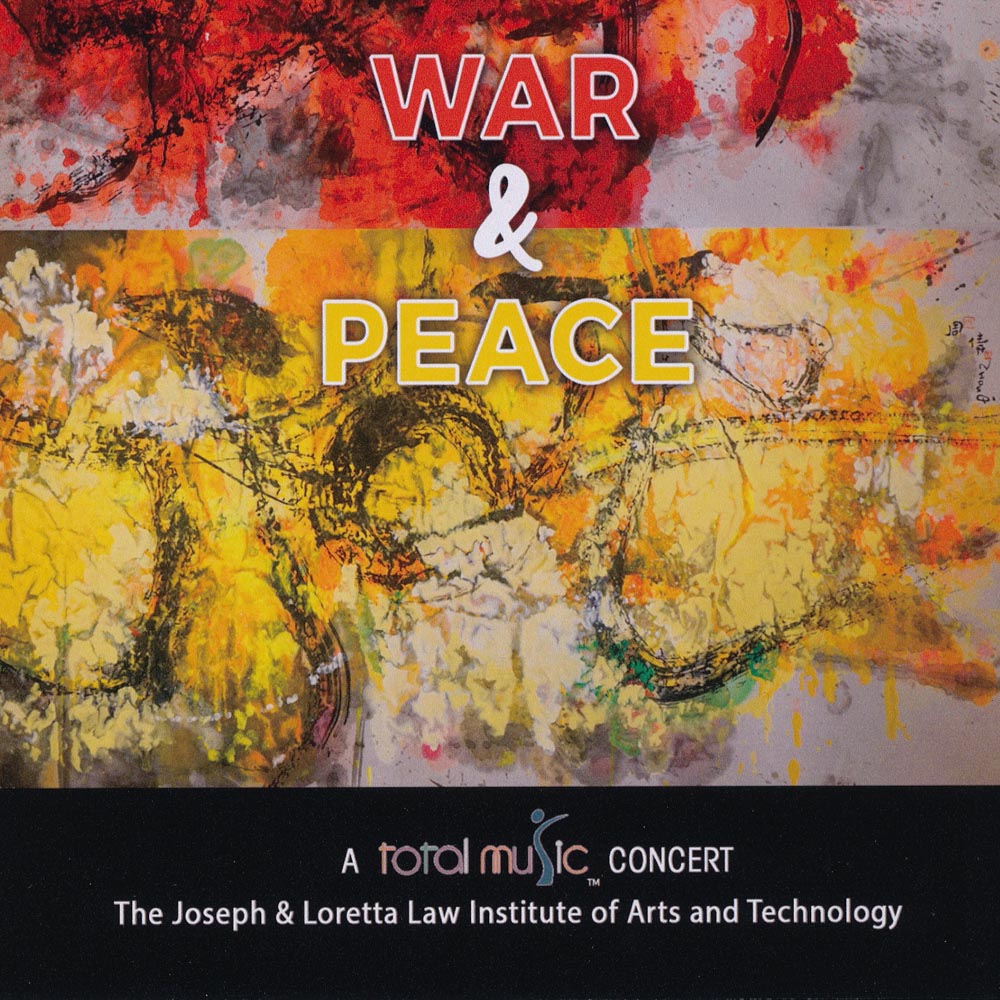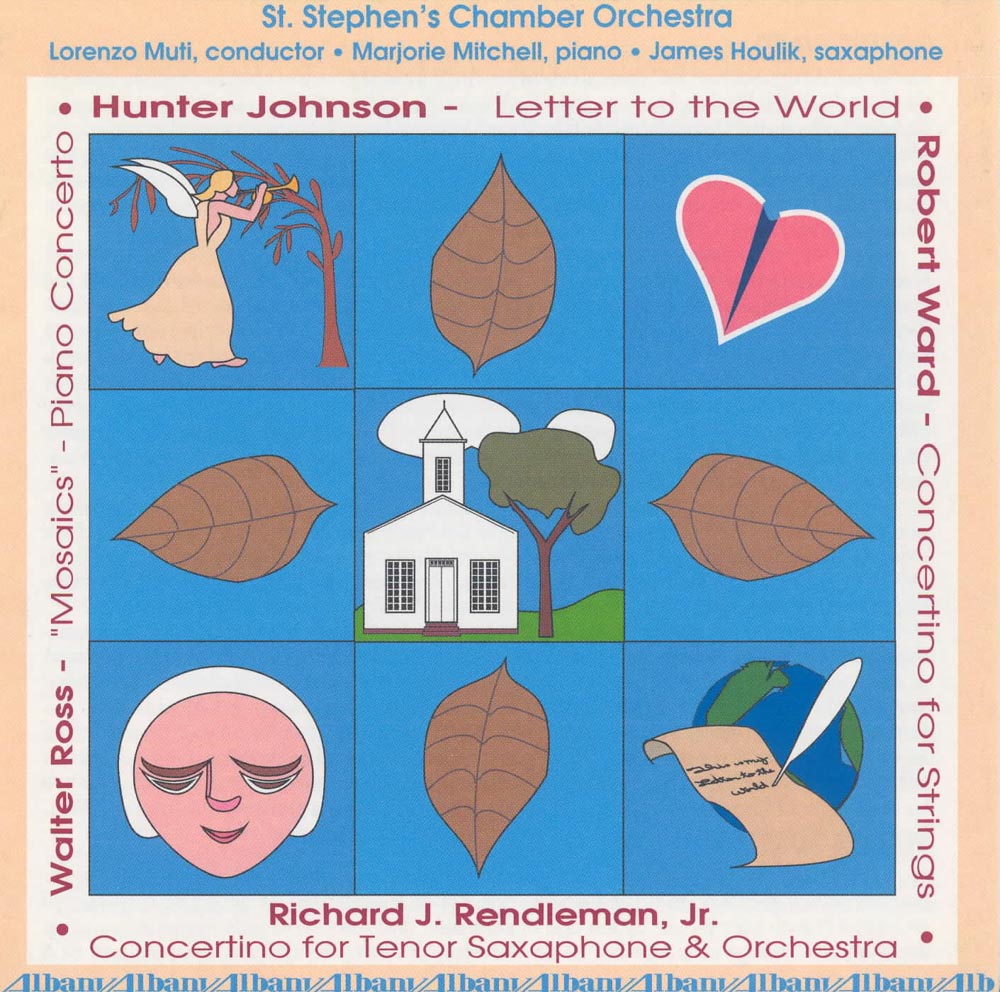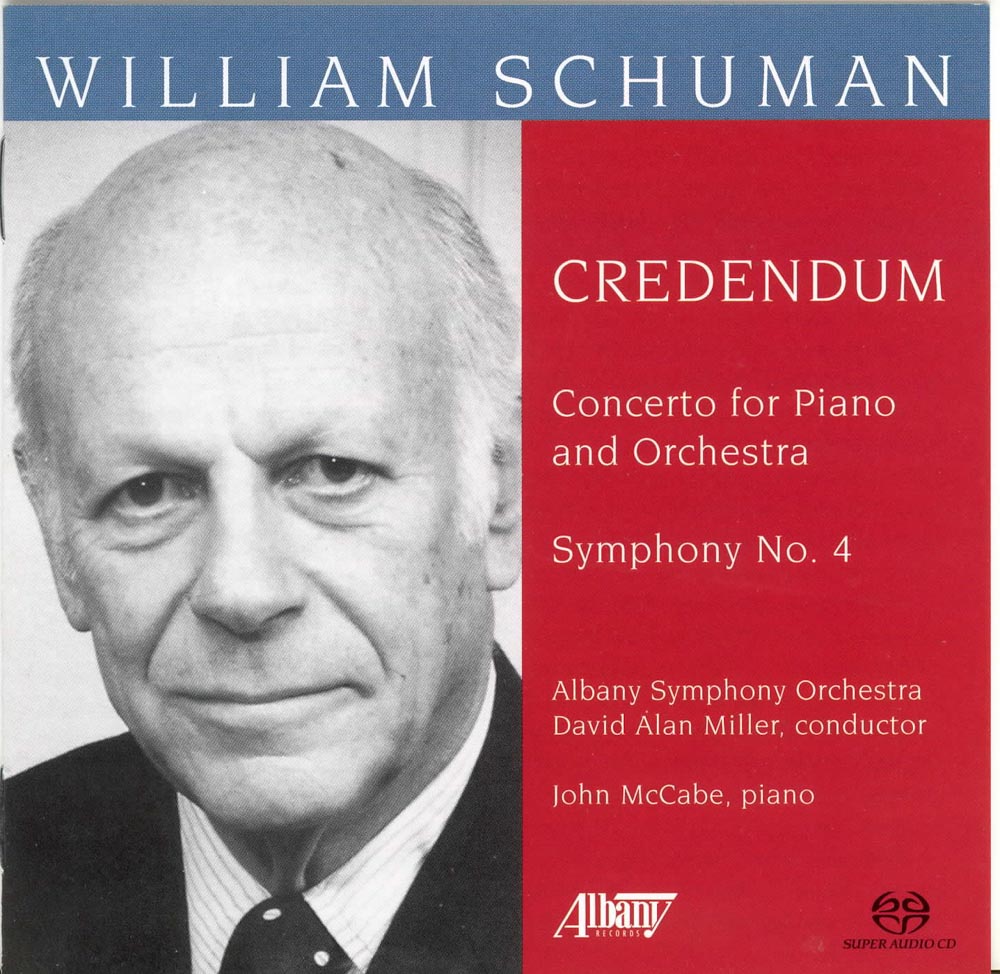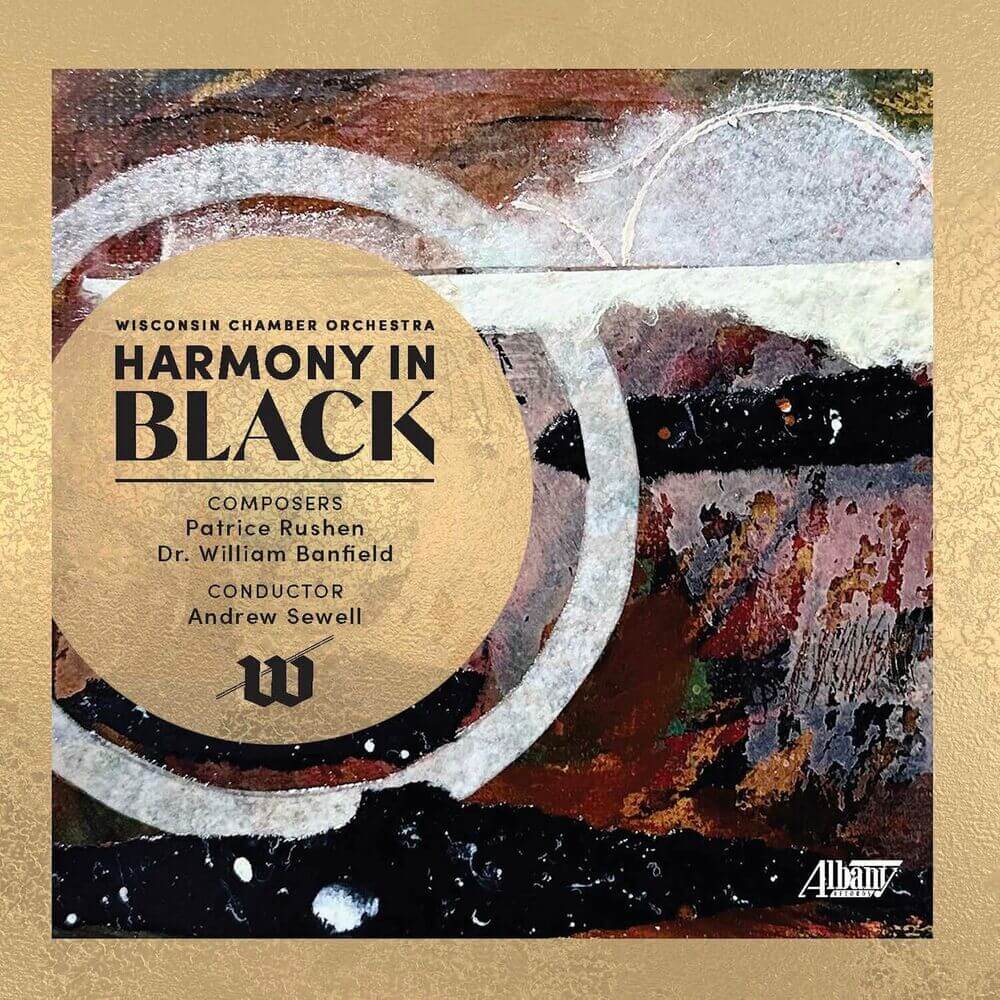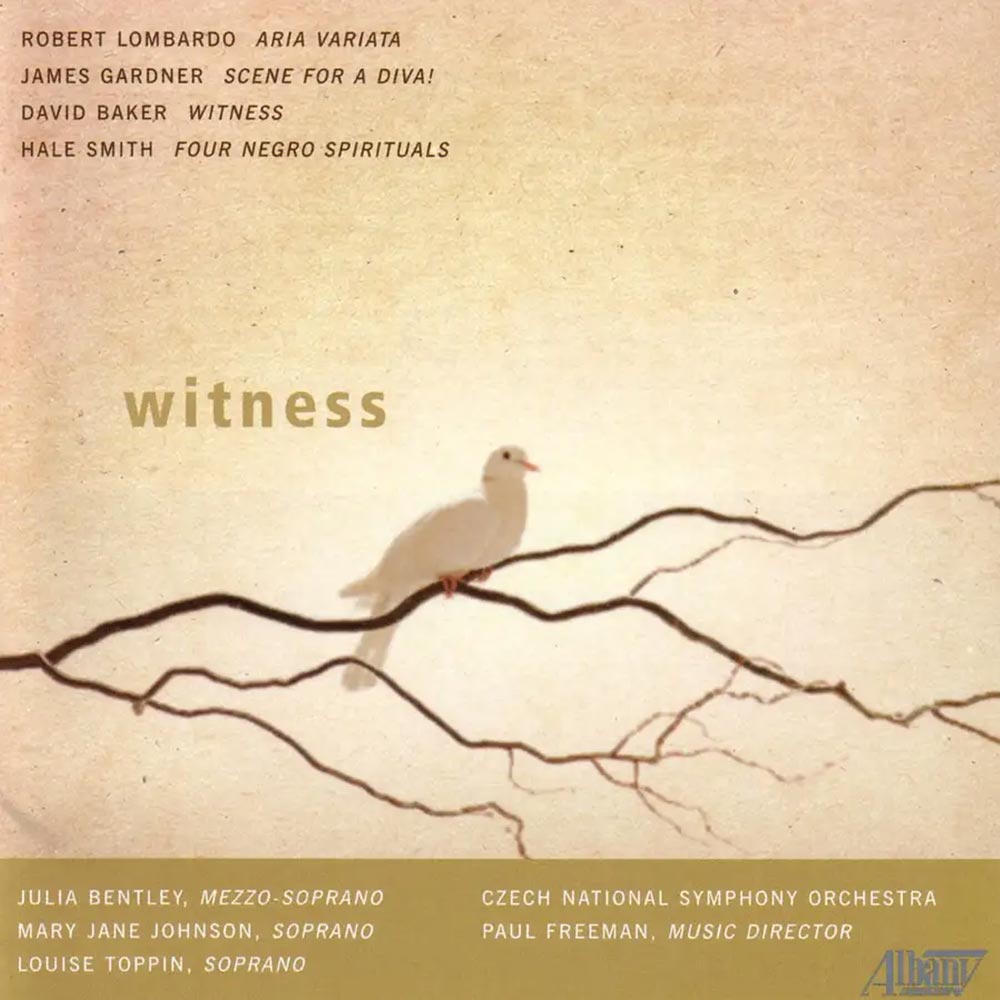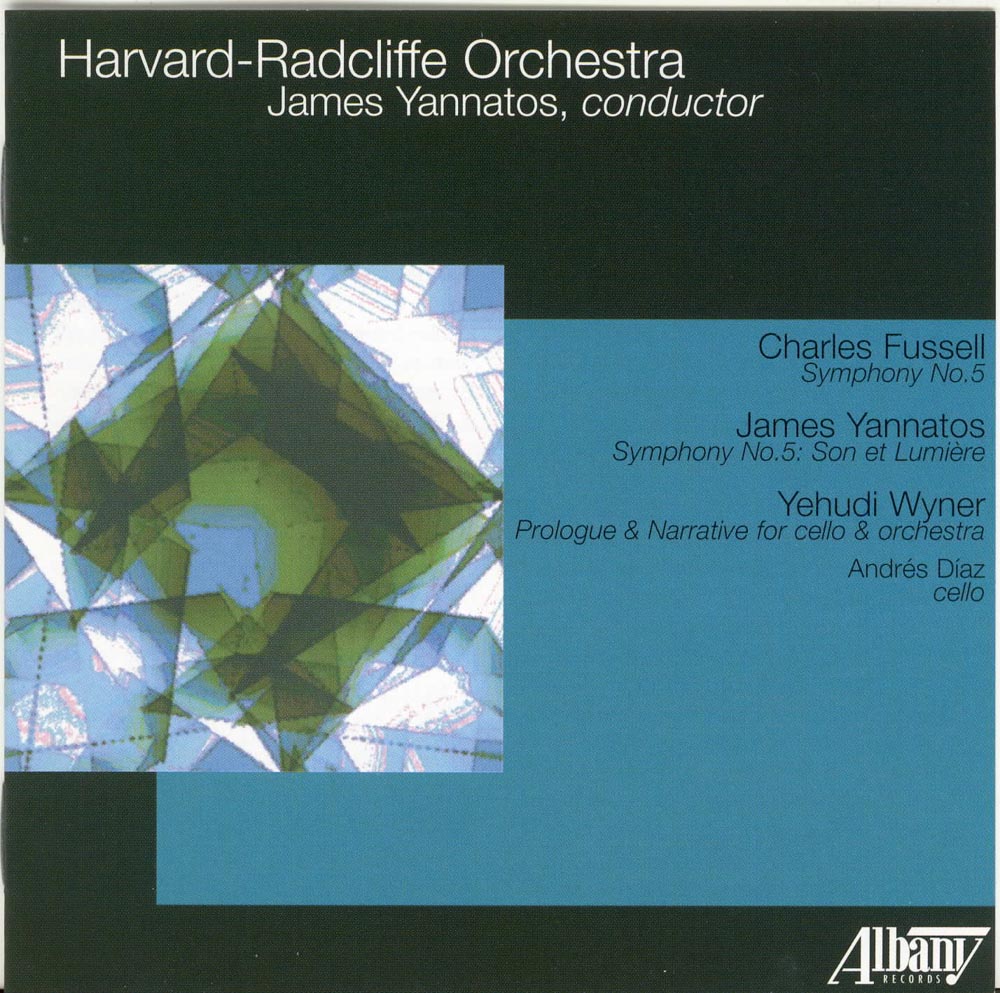Catalog #: TROY0711
Release Date: November 1, 2004OrchestralTim Page has described Five as "...another in a distinguished series of compositions Wuorinen has written for the cellist Fred Sherry. Dating from 1987, it is the most recent piece on this disc and (to employ, reluctantly, what has become an increasingly noxious code word) probably the most "accessible."" Five was commissioned by the New York City Ballet for their 1988 American Music Festival. Fred Sherry writes: "Five is a cellist's showpiece, a dance, a thrill for the audience, and a beautiful example of Wuorinen's versatility and technique." Michael Steinberg writes: "The Golden Dance was commissioned with the cooperation of the San Francisco Symphony by the Meet the Composer Orchestra Residencies program. It was written for Herbert Blomstedt and the San Francisco Symphony on the occasion of the Orchestra's 75th anniversary. It was completed in May, 1986 and was introduced on September 10, of that year. Wuorinen, who likes to make his titles topical and, if possible, punning, has called this piece for San Francisco The Golden Dance. No need to elaborate on the associations called up by the word 'golden' in California. The other meaning is not obvious, and that is the role played in the design by the golden section, that classical division of a line, thought by the Greeks to yield an aesthetically perfect proportional relationship, where the smaller section is to the larger as the larger is to the whole." The Concerto for Amplified Violin and Orchestra was commissioned by the Fromm Music Foundation for Paul Zukofsky, Michael Tilson Thomas and the Boston Symphony Orchestra. It was composed between June 25, 1971 and April 2, 1972 and premiered at Tanglewood on August 4, 1972. The Concerto is in three movements and is marked by a unique relationship between soloist and orchestra; they are on an equal acoustic footing. The amplification of the soloist enables him to compete with the entire orchestra at full volume. The impact is visceral and immediate.
Catalog #: TROY0350
Release Date: July 1, 1999OrchestralA few years back when the regular stereo version of this CD was released, we called it "the ultimate release for the American Symphony fan." Well, in SACD format, it is of even more importance, since those magnificent orchestral colors truly shine in surround-sound! This has always been one of most popular CDs in our catalog, and probably went a long way in changing the minds of those who thought Harris only wrote one Symphony - No. 3. Admittedly, when you see the cover with its "Great American Ninth" in large letters, you will be right to think we have gone "commercial." Garish? You are right! Hype? Right again! This is wonderful American music that should appeal to the same public who likes Aaron Copland, Morton Gould and Leonard Bernstein - and the crowd that loves to hear a big orchestral sound coming from their 5.1 Surround systems!
Catalog #: TROY1756
Release Date: January 1, 2019OrchestralBorn in 1905, Eric Zeisl fled Austria in 1938, coming to the United States, and committing himself to applying his mastery of classical compositional technique to commemorating the destroyed Jewish European heritage. He met Benjamin Zemach at the then new Brandeis-Bardin Institute, where Zemach headed the dance and theater department. The two men set out to create two biblical ballets, one of which, Jacob and Rachel, is performed on this recording. Zemach expertly distilled the dramatic elements of the old stories into scenes, and Zeisl composed the musichis forte was exactly that, depicting characters, actions and emotions in music. The second work on this recording, Variations on a Slovakian Folk Song, derives its theme from a book of folksongs called Slowakisch. The translation of the text is: Lord God mine, Father mine, give the world your light and justice. Every day your poor servant suffers terribly. The mission of the Los Angeles Jewish Symphony is to perform orchestral works of well-known as well as not widely recognized Jewish composers. The LAJS is the only orchestra in America dedicated to the performance and preservation of orchestral works of distinction that explore Jewish culture, heritage, and experience. Led by artistic director Noreen Green, who founded the orchestra in 1994, the LAJS celebrates the richness of Jewish music, sharing it with diverse audiences. Dr. Green is known worldwide for her knowledge and skill in presenting music with Jewish themes. She has served as guest conductor in the United States, Israel, South Africa, Australia, and Canada. In 2017, Musical America recognized her as one of its Movers & Shapers the Top 30 Musical America Professionals of the Year.
Catalog #: TROY0796
Release Date: October 1, 2005OrchestralPraised by the New York Times as a "young composer of great gifts," Larry Alan Smith has developed an international reputation as a composer, performer, educator and arts executive. He pursued his musical studies with Nadia Boulanger in France and at the Juilliard School with Vincent Persichetti. From 1980 to 1986 he also taught at Juilliard; previously he was on the composition faculty of the Boston Conservatory. It's always a pleasure to welcome a new name to the catalog, especially when this release features significant orchestral works: the Three Movements, full of drama and virtuoso writing; the introspective Crucifixus, the Symphony No.2 with its program describing the relationship of man and the world (with a depiction of the Civil War battle at Antietam, West Virginia) and the charming Serenade, a wedding present to his wife Marguerita. This is an exceptional way to make your acquaintance with an important American composer.
Catalog #: TROY0704
Release Date: November 1, 2004OrchestralLeroy Southers was born on July 13, 1941, in Minot, North Dakota, and died November, 2003. The recipient of numerous honors and academic degrees, including a Doctorate of Musical Arts & Composition from the University of Southern California, Leroy W. Southers, Jr. was an extremely accomplished musician. Member of the Composition faculty at the Berklee College of Music in Boston, he also taught in Los Angeles at the University of Southern California and at Loyola Marymount University. His Symphony for Chamber Ensemble was composed in 1967, when the composer was only 26. Lee T. McQuillan, a resident of Middletown, Connecticut, studied music Education at Barrington College in Rhode Island and later received his Bachelor of Music in Composition from the Hartt School of Music. His principal composition studies were with Arnoldo Franchetti. Romanza, subtitled Into Troubled Times (A 9/11 Reflection) was written to remember the great loss experienced by humanity on that momentous day in September, and to honor those who suffered the ultimate loss. Originally from Baltimore, Beth Denisch earned her undergraduate degree in music composition from North Texas State University and the Masters of Music and Doctor of Musical Arts degrees in composition from Boston University where she studied with John Harbison and Bernard Rands. Golden Fanfare was commissioned by The Brockton Symphony Orchestra of Brockton, Massachusetts for their 50th anniversary in 1998 and revised for subsequent performances as recorded here. Jack Jarret is a native of Asheville, North Carolina. His academic credentials include a B.A. from the University of Florida, and M.A. from the Eastman School, a Diploma in conducting from the Berlin Hochschule fur Musik, and a Doctor of Music in Composition from Indiana University. He has studied with Boris Blacher, Bernhard Heiden, and Tibor Kozma. From 1989 to 1999, he was chairman of the Composition Department at the Berklee College of Music. His Symphony No. 1 was composed in 1996. In style, it is closer to the classical romanticism of Tchaikovsky or Shostakovich than that of Strauss or Mahler. It is in four movements.
Catalog #: TROY0342
Release Date: August 1, 1999OrchestralSolstice, by Donald Erb, is celebratory in nature. It was commissioned by the Ohio Chamber Orchestra and premiered on June 3, 1988. It was originally intended to celebrate the 50th anniversary of the Organization, but the premiere occurred one year later. About his Lyric Intermezzo George Perle writes: "The Lyric Intermezzo was composed on commission from the Seattle Symphony and completed April 12, 1987, but its very first conception goes back some years before that, when my friend (now my wife), Shirley Rhoads, played Schumann's Waldszenen for me. I decided that I too would like to write a set of lyrical Charakterstucke for the piano." William Duckworth's Mysterious Numbers stemmed from an experiment that essentially involved collaboration of a composer with an ensemble to create a new work while an audience witnessed the process during a series of workshops. It happened in Florida in 1995-96, as part of a series of residencies at the Atlantic Center for the Arts by the New Performance Group of Seattle. Salvatore Martirano writes about Isabela "that it was originally aimed at music festivals celebrating the 500th anniversary of the discovery of America. However, music festivals celebrating Columbus ran aground as the implications for native Americans became apparent. Whether from habit or from a persistent motive, what started as a working title became a name as I considered that like Columbus, who began a journey across the sea without knowing where his course would lead him. "I began to compose without really knowing what would result from my plan." This disc contains the result of Martirano's own voyage.
Catalog #: TROY0686
Release Date: October 1, 2004OrchestralChristopher Gunning was born in Cheltenham, Gloucestershire, but spent his childhood in London. He studied composition, piano and percussion at the Guildhall School of Music and Drama, where his teachers included Edmund Rubbra and Richard Rodney Bennett. For most of his professional life he has composed film and television scores. He currently divides his time between composing for films and television, conducting engagements, and composing his own concert works, the most recent of which was a Saxophone Concerto for John Harle. The composer writes: "I had wanted to write a piano concerto for several years before finally getting to grips with it in 2001. So much contemporary piano music seems to ignore that which I like best - the instrument's ability to sing - and I was interested in doing something which explores the lyrical as well as the percussive qualities of the piano. Storm composed early in 2003 has slow outer sections; apart from those it is pretty noisy and dramatic. It is scored for a large symphony orchestra, and I wrote it shortly after spending some time at the seaside and feeling totally exhilarated by the wind and waves of a violent storm. Symphony No. 1, composed in 2002, continues a process begun a few years previously with my Saxophone Concerto, which was my first concert piece following many years of working in films and TV. It was then that I discovered a penchant for single movement forms which move through many changing emotional moods; I think of them as novels or journeys."
Catalog #: TROY0782
Release Date: August 1, 2005OrchestralIn his third recording for Albany Records, the spectacular horn player, Eric Ruske, presents a program of concertos for French horn written by the Romantic composers Reinhold GliFre, Franz Strauss and Richard Strauss. According to Ruske, "...the Romantic era of musical composition ushered in a golden period for the horn as a solo instrument.... With the chromatic possibilities and technical advances that were made possible by the addition of valves in the early 19th century, the horn made its resurgence as a solo vehicle." Eric Ruske has established himself as an artist of international acclaim. Named Associate Principal horn of The Cleveland Orchestra at the age of 20, he also toured and recorded extensively during his six-year tenure as hornist of the Empire Brass Quintet. His impressive solo career began when he won the 1986 Young Concert Artists International Auditions, First Prize in the 1987 American Horn Competition, and in 1988, the highest prize in the Concours International d'InterprTtation Musicale in Reims, France. His discography includes solo recordings for Telarc, Musical Heritage Society, Fleur de Son, and Albany Records. An Associate Professor and member of the faculty of Boston University since 1990, Mr. Ruske also directs the Horn Seminar at the Boston University Tanglewood Institute.
Catalog #: TROY1816
Release Date: July 1, 2020OrchestralChristopher Theofanidis' music has been performed by many of the world's leading performing arts organizations, from the London Symphony, Philadelphia Orchestra, and the New York Philharmonic to the San Francisco Opera, Houston Grand Opera, and the American Ballet Theatre. A two-time Grammy nominee, Theofanidis is currently on the faculties of Yale University and the Aspen Music Festival. This recording of two of his concertos is performed by the Albany Symphony conducted by David Alan Miller, which is known for its commissioning and performances of music by American composers. Chee-Yun, violin soloist is a winner of the Young Concert Artists International Auditions and has performed with many of the world's foremost orchestras. Viola soloist Richard O'Neill is the newly appointed violist of the Takács Quartet. An EMMY Award winner, two time Grammy nominee and Avery Fisher Career Grant recipient, he has appeared as soloist with the world's top orchestras.
Catalog #: TROY1552
Release Date: February 1, 2015OrchestralThe distinguished American composer Thomas Pasatieri is well known for his operas, having composed 22, as well as for his hundreds of songs and other vocal works. In fact, his first symphony, written at age 63 came about because of his association with the University of Kentucky and their production of his opera, The Hotel Casablanca. His Symphony No. 2 was written for conductor John Nardolillo and the University of Kentucky Symphony Orchestra as well, while Symphony No. 3 was commissioned and premiered by the Northwest Sinfonietta. These are world premiere recordings of these works.
Catalog #: TROY1475
Release Date: January 1, 2014OrchestralThomas Sleeper enjoys an active dual career as composer and conductor. His compositions include three symphonies, six operas, 14 concerti and numerous chamber works. His music is regularly performed through the U.S., in Europe, Asia and South America. He is director of orchestral activities at the University of Miami's Frost School of Music and music director of the Florida Youth Orchestra. With this world premiere recording of four of his concerti, we discover a composer in full control of his considerable faculties. His musical voice is oblique, as language in a dream, which tends to evaporate the more you attempt to sharpen your focus. These works display a composer with something interesting and important to say in a voice that is uniquely, authentically and unmistakably his.
Catalog #: TROY1212
Release Date: September 1, 2010OrchestralThomas Sleeper enjoys a highly prolific career as both composer and conductor. An active guest conductor in the U.S. and abroad, Sleeper has appeared with more than 30 orchestras on four continents. His compositional oeuvre to date includes two symphonies, two orchestral song cycles, eight concerti, six operas, numerous chamber and solo works and music for film. Sleeper is the Director of Orchestral Activities at the University of Miami's Frost School of Music.
Catalog #: TROY0103
Release Date: November 1, 1993OrchestralFueled by the brashness of a young nation, nineteenth century America produced a group of composers as diverse as the people who created the United States. They created a body of music that was distinctly American in sound and spirit. They were teachers, conductors, performers, publishers and administrators, but first and foremost, they were composers. Composers of music that moved the feet, sang the praises and expressed the hopes and desires of the American people. Who were they? Francis Johnson (1792-1844) was an American-American probably born in Philadelphia. Hailed during his lifetime as America's first native born master of music, he was a skilled performer on the keyed bugle, violin and piano. William Henry Humiston (1869-1923) was born in Marietta, Ohio. Easily the most enigmatic of the composer on this recording, Humiston was primarily an organist. He studied composition with Edward MacDowell from 1986-1899 and became assistant conductor of the New York Philharmonic in 1916. Harry Rowe Shelley (1858-1947) was one of the few American composers of his generation to study exclusively in the United States. Born in New Haven, Shelley studied at Yale University with Gustav Stoeckell and later with Dudley Buck and Antonin Dvorak in New York. Shelley was an organist at various churches in Manhattan and Brooklyn until his retirement in1936. George Whitefield Chadwick (1954-1931) was an American original, an independent Yankee who rose from humble origins to a position of prominence on his own merits. Founder of the Music Teachers National Association, Chadwick used his salary from his father's insurance firm to finance his musical education. Edgar Stillman Kelley (1857-1944) was a prolific composer of programmatic works noted for his innovative orchestration. Born in Sparta, Wisconsin, Kelley studied with Clarence Eddy in Chicago with further studies in Stuttgart. Kelley taught at the Cincinnati Conservatory of Music for more than 20 years.
Catalog #: TROY1643
Release Date: September 1, 2016OrchestralThe Albany Symphony, conducted by David Alan Miller, gives world premiere performances of two commissioned works by the distinguished American composer Michael Torke. Torke's music has been called "some of the most optimistic, joyful and thoroughly uplifting music to appear in recent years." (Gramophone) Hailed as a "master orchestrator whose shimmering timbral palette makes him the Ravel of his generation" (New York Times), Michael Torke has created a substantial body of works in virtually every genre. Torke has served as Composer In Residence for the Royal Scottish National Orchestra and has founded Ecstatic Records. The two works on this recording include a concerto for piano and orchestra titled Three Manhattan Bridges. Torke uses bridges as a metaphor for connecting to an earlier stance that music once had of a direct relationship with its audience. The second work, titled Winter's Tale is a concerto for cello and orchestra. Though not based on Shakespeare's The Winter's Tale, it is inspired by lines from the play.
Catalog #: TROY0942
Release Date: July 1, 2007OrchestralRoberto Sierra's Sinfonias burst with color and excitement, mixing popular and classical idioms, reflecting his Puerto-Rican heritage. As he writes, "That is how I hear music: in Technicolor, not black and white. It's not only timbre, it's harmony! I believe that different colors have different emotions." Currently serving as Old Dominion Professor of Composition at Cornell University, Sierra was composer-in-residence with the Milwaukee Symphony from 1989-1992 and with the Philadelphia Orchestra in 2000-2001. His three symphonies constitute a revealing window into his evolution as an orchestral composer.
Catalog #: TROY1108
Release Date: April 1, 2009OrchestralA stunning program of works for soloists with wind ensemble is presented in this recording made by the University of Arizona Wind Ensemble. Acclaimed saxophonist Timothy McAllister performs a work by Daniel McCarthy inspired by the funk-horn band, Tower of Power. Brian Luce, a superlative flutist, performs in one of a handful of works written for flute with wind ensemble, while the great Jonathan Haas is joined by timpanist Gary Cook in performing Glass' work for 14 timpani with wind ensemble, creating a new sound out of the incredibly large sonorities.
Catalog #: TROY1017
Release Date: April 1, 2008OrchestralLee Actor's career as a software engineer and a musician began in Albany, New York: for several years he was a violinist in the Albany Symphony Orchestra while completing an advanced engineering degree at Rensselaer Polytechnic Institute in nearby Troy. After moving to California in the late 1970s, he studied with Brent Heisinger, Charles Jones and the late Andrew Imbrie. Actor's music is filled with rhythmic drive and shows a superb ear for orchestral color. Often he builds up a work by emphasizing one or another of the instrumental families Ð woodwinds, brass and strings Ð then mixes them in a rich impasto of orchestral color. In the process he creates music that catches the ear and draws the listener into a world of emotion and drama. All of these recent works are a perfect showcase of his distinct range and style.
Catalog #: TROY0737
Release Date: February 1, 2005OrchestralRay Bono writes in his program notes: "Fiercely independent. Self Reliant. Self-disciplined. Such descriptions invariably surface in accounts of Paul Creston's life. More emphatic is the assertion that, excluding keyboard lessons, he was "entirely self-taught" in music. And, in fact, the short, affable Italian-American was in many ways a supremely self-made man, even down to his name. Born on October 10, 1906 in Manhattan to an impoverished couple from Sicily, he was christened Giuseppe Guttovergi (the family name would later be recast as Guttoveggio). In childhood he was also called Joseph but by 15 had been dubbed Cress by his friends, after Crespino, the role he played in a high-school staging of Goldoni's comedy, The Fan. Before long, he reworked this Cress into a fuller, solidly American-sounding name - and exit Giuseppe-Joseph-Guttovergi-Guttoveggio; enter Paul Creston. He started composing at the age of eight, soon after his parents, recognizing his musical ability, managed to get him a piano and a teacher. Within a few years, he was capable enough to substitute for the teacher when the man was ill - and canny enough to deem the man musically incompetent. He moved on to better piano teachers, took organ lessons too and plunged into a ferocious self-directed study of the works of Bach, Rameau, Scarlatti, Rimsky-Korsakov, Chopin, Debussy and Ravel. These masters of form, harmony and color, he would always maintain, were his true teachers; from them alone did he learn composing and orchestration. From the onset of the Great Depression, when he wasn't trying to sell insurance or real estate, Creston was accompanying singers as a Musicians Emergency Fund member - and pondering a career as a writer. Or a concert pianist. Or a composer. After a favorable response to a set of dances he wrote for solo piano in 1932, and to his incidental music for a theater piece - and encouraged by composer and concert organizer Henry Cowell, he sat down, took stock of his talents and decided to concentrate seriously on composition. His early modest pieces were successful enough to earn him a positive mention in Aaron Copland's 1936 article about "America's young men of merit" (although Copland grouped him with rising composers whose work tended to be "somewhat" abstract"). Larger works followed, and more attention. He received two successive Guggenheim fellowships. And his Symphony No. 1, debuting in 1941, won the New York Music Critics' Circle Award and later took first prize in an international competition in Paris. The three orchestral works on this disc - a symphony, a concerto and what amounts to a musical diptych - are from Creston's finest period. Never before recorded for commercial release, they exemplify his talent for uniting lyricism with propulsiveness to make a considerable emotional impact."
Catalog #: TROY0592
Release Date: September 1, 2003OrchestralSteve Margoshes is the composer of the international hit musical Fame. The inspirational musical about New York City's High School of Performing Arts (written with lyricist Jacques Levy) has been performed on every continent in the world in a dozen languages. This CD continues Steve's collaboration with Fame creator, David De Silva aka Father Fame, to produce a new body of work for symphony orchestra. He has composed and orchestrated these "symphonic pop" pieces under the banner Symphonic Fame. Steve's work as an orchestrator in the theater includes the Who's Tommy, Smokey Joe's CafT (the songs of Leiber and Stoller) and the Elton John/Tim Rice musical, Aida. Barnabas Kelemen was born in Budapest in 1978. He has studied at the Liszt Academy of Music in Budapest since 1990 and in 2002 was named the gold medalist at the International Violin Competition in Indianapolis. This is the first release in a new series from Albany Records called "American Light" which is classical music presented with a lighter touch. The British have been doing this sort of thing for years: presenting "light" music by serious composers and we feel that it is time we catch up. This series will present well-crafted music by serious composers whose music should appeal to a larger audience without pandering to it.
Catalog #: TROY0646
Release Date: March 1, 2004OrchestralElliott Schwartz was born in New York City and studied composition with Otto Luening and Jack Beeson at Columbia University. Since 1964, he has taught at Bowdoin College, where he is currently the Robert K. Beckwith Professor of music. There are five orchestral works on this disc which share a number of traits - in particular, a fondness for bright, splashy instrumental colors, multi-layered textures (akin to photographic "multiple exposure"), eclectic style juxtapositions, and references to pre-existent music of the past. Many of the principal motives are derived from patterns - number sequences, or musical spellings - which are related to extra-musical programmatic sources. Moreover, these pitch patterns often expand into twelve-tone rows (which in turn generate new patterns). The musical surfaces, however, are far removed from the world of strict serialism. Quite the opposite, in fact: tonal, triadic passages and angular, dissonant ones jostle each other, and controlled improvisation often flows through and around strictly notated narrative. Finally, a distinctly "theatrical" strain runs through these compositions. Performers may be asked to walk or speak; orchestra choirs - the wind section, or the brasses (appropriately at the rear of the stage), may play "competing music" - fragments of pre-existing material - at odds with the prevailing music that surrounds them. Unusual instruments - metronomes, police whistles, flashlights, or piano interiors - may be employed by the players. These are intended to create a multi-dimensional, and perhaps even dream-like, experience.
Catalog #: TROY0486
Release Date: March 1, 2002OrchestralComposer and conductor, Anthony Iannaccone, is one of a handful of contemporary artists whose exploration of musical polarities in the 1960's and 70's consistently separated their output into populist and specialist works. In the world of music, the former tended to be tonal and accessible, while the latter leaned toward atonality and abstraction. In his own case, Iannaccone refers to these categories as "large-audience" and "small audience" music, respectively. The first three pieces on this disc demonstrate a remarkable blending and balancing of both "small" and "large-audience" music. The last two works clearly inhabit the realm of the "large-audience." Not unlike the overview afforded on earlier Albany releases of Iannaccone's music for strings (TROY 414) and music for winds (TROY 280), this CD includes works that span nearly two decades of music for the orchestral medium. From his earliest orchestral venture, Suite for Orchestra, to his most recent, From Time to Time, one can trace the development of a truly personal voice from an early mixture of influences, both traditional (Brahms, Debussy, Mahler) and modern (Stravinsky, Berg, Copland, Bartok).
Catalog #: TROY0270
Release Date: January 1, 1998OrchestralThe Pulitzer Prize winning composer, George Walker, composed his Serenata for Chamber Orchestra for the Michigan Chamber Orchestra. It received its premiere in Detroit in October 1983. It received another performance by the New York Philharmonic in July 1984 on a Horizon's 94 concert. The Lyric for Strings was composed in 1946 and premiered that year by the student Orchestra of the Curtis Institute of Music conducted by Seymour Lipkin in a radio concert. It received another performance the following year by Richard Bales and the National Gallery Orchestra. The Poeme for Violin and Orchestra was premiered by the St. Paul Chamber Orchestra with Cho-Liang Lin as violin soloist in 1991. It is a revised version of an earlier Violin Concerto. Orpheus for Chamber Orchestra was commissioned by the Cleveland Chamber Orchestra and was completed in 1994. It received its premiere in March 1995. Besides the Chamber Orchestra, it includes a part for narrator and singer. The Folk Songs for Orchestra were completed in the fall of 1990 and was premiered in May 1992 by the Baltimore Symphony under David Zinman. The composer describes his intention as "to set these melodies in an interesting way, in a respectful Orchestral manner. They are wonderful melodies. Four spirituals are quoted intact."
Catalog #: TROY0557
Release Date: March 1, 2003OrchestralNot to be confused with the Scottish composer William Wallace (1860-1940), this William Wallace is a man of our time. His works, widely performed and broadcast. He studied with Leroy Robertson at the University of Utah and Egon Wellesz and Edmund Rubbra at the University of Oxford. He has taught at both Rutgers University and Canada's McMaster University. He holds both U.S. and Canadian citizenship and lives in Jackson Hole, Wyoming.
Catalog #: TROY1776
Release Date: December 1, 2019OrchestralWar & Peace is a video production released in Blu-Ray format and conceived as a total entertainment concept. The production combines artistic resources from other cultures with advancing techinologies in order to create music that impacts our senses in a manner seldom achieved before. Art, dancing, music, western and eastern cultures all combine to push the boundaries of musical entertainment by using new combinations of musical instruments, new multicultural art direction and new dance styles. War & Peace provides an entirely different visual and auditory impact to the audience. Entertaining sounds and rhythms, beautiful and meaningful visual imagery, and culturally diverse creative expressions are the hallmarks of War & Peace.
Catalog #: AR0001
Release Date: June 1, 1988OrchestralPulitzer Prize winning composer Robert Ward was born in Cleveland, Ohio on September 13, 1917. He received his early musical training in Cleveland's public schools and graduated from the Eastman School of Music where he studied with Bernard Rogers and Howard Hanson. His graduate work was undertaken at the Juilliard School studying composition with Frederick Jacobi and conducting with Albert Stoessel and Edgar Schenkman. During that time he was also a student of Aaron Copland at the Berkshire Music Center. Before and after World War II, Ward served on the faculties of Queens College, Columbia University and the Juilliard School, later becoming music director of the Third Street Music School. In 1956 Ward became the Executive Vice President and Managing Editor of Galaxy Music Corporation and Highgate Press. In1967 he was named President of the North Carolina School of the Arts and in 1979 became Mary Duke Biddle Professor of Music at Duke University.
Catalog #: TROY0111
Release Date: March 1, 1994OrchestralThis recording features the St. Stephens Chamber Orchestra performing works by North Carolina composers. Central to the recording is Hunter Johnson's Letter to the World. Hunter Johnson (b. 1906, Benson, North Carolina) composed extensively for piano, various chamber ensembles and orchestra. He is perhaps best known for his much-performed piano sonata and two ballets commissioned by Martha Graham, each of which has had hundreds of performances worldwide by the Graham Dance Company. Of the many artistic homages that have been paid to the spirit and poetry of Emily Dickinson, one of the finest tributes is Martha Graham and Hunter Johnson's collaboration, Letter to the World. Premiered in1940, this synthesis of dance, music and poetry soon became an established modern dance classic. The music (and dance) describe the legend of Emily Dickinson and the world of her imagination rather than the actual facts of her real life. Other works on the recording include Robert Ward's Concertino for Strings; Walter Ross's Mosaics; and Richard Rendleman's Concertino for Tenor Saxophone and Orchestra.
Catalog #: TROY0566
Release Date: March 1, 2003OrchestralThose of you who know your English composers; yes, indeed, it is John McCabe who is the piano soloist in the Schuman Piano Concerto. In fact, it was John who recommended that the Orchestra perform the piece in the first place. In the new SACD format, this is a great demonstration disc to show just how good the modern orchestra can sound. Here, Credendum appears for the first time ever in stereo in any format. It is one of the loudest pieces of music ever written. The work takes its name from the Latin for "that which must be believed." It was commissioned through the Department of State (the first time a government agency had ever commissioned a piece of music) to honor UNESCO, the United Nations organization in charge of coordinating arts, science and education programs worldwide. It was premiered by the Cincinnati Symphony Orchestra, Thor Johnson conducting, on November 4, 1955, in a special concert honoring the Fifth National Conference of the United States National Commission for UNESCO. The Concerto for Piano and Orchestra was originally derived from an unperformed concerto fashioned in 1938-39 and was called Concerto for Piano and Small Orchestra. It exists in an altogether other universe from the sweeping concertos of Brahms, Grieg and Tchaikovsky. Which may clarify why one disgruntled listener, in Manhattan's Town Hall on January 13, 1943, demanded that Daniel Saidenberg - who had just led the Saidenberg Little Symphony and pianist Rosalyn Tureck in the premiere performance - explain himself. "You conduct modern music," the young woman said. "Why?" William Schuman considered himself first and foremost a symphonist, and his Fourth Symphony dates from his period of greatest industry in that form, during and shortly after World War Two. (To his regret, physical disabilities disqualified him from military service). The Third arrived in late 1941, the Fourth a few months later, the Symphony for Strings (No. 5) in late 1942 and the masterful Sixth in 1948. Aaron Copland heard a performance of this symphony in the early 80s at Tanglewood and phoned Schuman to rave about the piece, calling it "wonderful" and claiming to have been wholly unfamiliar with it. On the contrary - Schuman reminded him - not only had Copland already read through the score but Schuman had even revised the end of the second movement based on the senior composer's comments. But then, that had been four decades prior: the symphony was premiered by the Cleveland Orchestra under Artur Rodzinski (to whom it was dedicated) on January 22, 1942 - a few scant weeks after the attack on Pearl Harbor.
Catalog #: TROY0799
Release Date: December 1, 2005OrchestralAs we pointed out in our previous release of Wallace's orchestral music (TROY557), he is no relation to the Scottish composer of the same name who lived from 1860-1940. He is definitely a modern composer with roots in traditional Romanticism but with contemporary elements that give his music a fresh sound. His principal teachers were Utah's Leroy Robertson, Egon Wellesz and Edmund Rubbra. The last is the composer Wallace most resembles; the Concerto Variations is a work of grand stature, similar in scope to the British master's earlier Symphonies. In contrast is the delightful Second Dance Suite and Cantilena, which reveal Wallace's affinity for Baroque forms. The Viola Concerto is a concise, lightly-scored work which certainly makes a welcome contribution to the still-small repertoire of modern works for the instrument. This will have great appeal for listeners who enjoy neo-Romantic music.
Catalog #: TROY1969
Release Date: February 15, 2024OrchestralHarmony in Black is part of a five-year initiative by the Wisconsin Chamber Orchestra that aims to elevate the voices of an array of living, diverse composers throughout the United States. For this first recording composers Patrice Rushen and William Banfield are featured. Their three compositions do not quote spiritual melodies directly but do embody the spirit of those songs by drawing either on direct quotation of speeches or writings. Multi-Grammy nominated artist Patrice Rushen is admired by many for her groundbreaking achievements including serving as Musical Director for the 46th-48th Annual Grammy Awards. Dr. William Banfield has produced a body of work in the past 25 years that includes music, books, teaching and creative work that contributes to contemporary arts leadership. Banfield is an award-winning composer who is now serving as Composer-in-Residence of the Wisconsin Chamber Orchestra.
Catalog #: TROY0868
Release Date: September 1, 2006OrchestralThe versatile and enterprising Paul Freeman, Julia Bentley, Mary Jane Johnson and Louise Toppin here introduce four works for soprano voice and orchestra, pieces which are thoroughly modern yet continue the grand tradition of the concert aria. Robert Lombardo received his master’s degree in composition from the Hartt School of Music. Aria Variata was commissioned by the Chicago String Ensemble and its director, Alan Heatherington. A native of Texas, James Gardner studied under Anshel Brusilow and Peter Herman Adler. Scene for a Diva expressly pays homage to the kind of concert aria composed by Mozart, written as if it were an actual opera aria, complete with dramatic recitativo and cantabile sections. David Baker is Distinguished Professor of Music and Chairman of the Jazz Department at the Indiana University School of Music. Witness was commissioned by Philip Brunelle for the Plymouth Music Series of Minnesota’s 1990-1991 season. They represent the composer’s reverent treatment of heartfelt and timeless spiritual texts. Another distinguished African-American composer, Hale Smith grew up performing both classical and jazz music. He chose these particular Four Negro Spirituals because he was deeply moved by the zeal of the songs. As an outstanding composer and arranger he has captured the essence of these songs with his brilliant orchestration.
Catalog #: TROY0481
Release Date: November 1, 2001OrchestralStanislaw Skrowaczewski retains a unique position on the international musical scene, where he is both a renowned conductor and a highly regarded composer, especially of large scale orchestral works. Born in Lwow, Poland but resident in the U.S. since 1960, Skrowaczewski showed great promise as a pianist, making his debut with the Beethoven Triple Concerto, but an injury to his hands during World War II terminated his keyboard aspirations. Composing and conducting became his double focus. Directly after the War - still in his mid-twenties - he was named music director of the Breslau Philharmonic, then the Katowice Philharmonic, Krakow Philharmonic and then the Warsaw National Orchestra. During this period he also studied with Nadia Boulanger in Paris. In 1958, at the invitation of George Szell, he made his American conducting debut with the Cleveland Orchestra. In 1960, he was named music director of what was to become the Minnesota Orchestra, a position he was to hold for 19 years. His Passacaglia Immaginaria was completed in 1995. It unfolds in a provocative sound world. Similar to the Passacaglia of the Baroque era, a species of continuous variations on a ground, his design is based on the principle of metamorphosis. The work was commissioned by the Minnesota Orchestral Association and Eiji Oue gave the premiere with the Orchestra on April 10, 12 and 13,1996. For its 35th anniversary season in 1993-94, the St. Paul Chamber Orchestra, requested a new work from Skrowaczewski. The resulting Chamber Concerto was premiered on November 26, 27, 1993. In January 1981, while guest conducting in Frankfurt, Germany, Skrowaczewski finished his Clarinet Concerto, which he dedicated to Joseph Longo, the co-principal clarinetist of the Minnesota Orchestra. The premiere of this work was April 15,17,18, 1981 and again the composer conducted the orchestra.
Catalog #: TROY0516
Release Date: August 1, 2002OrchestralAbout his Symphony No. 5 James Yannatos writes: "Symphony No. 5: Sons et Lumiere (1991) derives its title from the sound and light shows so popular in France in which historical events related to a particular epoch, chateau, or monument are dramatized through the use of sound and light. The title alludes to past as well as to present events in which the political face of Europe and Africa is changing. On another level, Sons et Lumiere refers to vibrations and waves that move through real time and space in the form of sound and interplay between the various levels of musical sound and meaning, referring to our physical world as we live it, our sensory world as we see, hear and feel it, and our spiritual world as we attempt to comprehend it." In May of every other year more than 900 cello lovers - from beginning cellists to esteemed cello soloists - congregate in Manchester, England for the International Cello Festival. The brain-child of cellist Ralph Kirschbaum, this festival features workshops, films, exhibitions, and performances by and for cellists. The Festival almost always features a premiere of a cello piece, and in 1994, Yehudi Wyner was commissioned to compose a piece for cello and orchestra. The result was the Prologue and Narrative for cello and orchestra, which Wyner himself describes: "Finding a title for the piece has been a difficult task. To call it a Concerto for Cello and Orchestra would be misleading, since the term "concerto" implies a form as well as a relationship. In general, my musical thinking is not comfortable with conventional modes of construction, nor does it rely on received conventions of form. While the music is constructed with great attention to contextual unity and formal coherence, it also strives for a sense of the informal, the improvisational, the spontaneous." Composer Charles Fussell was Artistic Director of New Music Harvest, Boston's first city-wide festival of contemporary music and Co-Founder and Director of the New England Composer's Orchestra. He is a member of the composition faculty at Boston University. His Symphony No. 5 was written in 1994-95 in memory of Virgil Thomson. The premiere was given November 1996 by the New Hampshire Symphony under the direction of James Bolle.
Catalog

©2024 Albany Records. All rights reserved. | Privacy Policy | Website by PARMA Creative.
